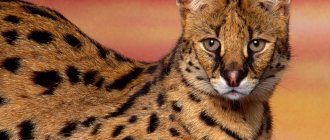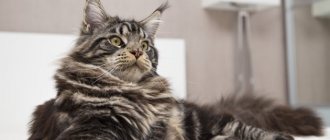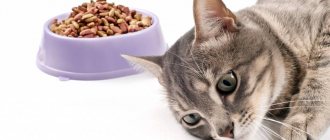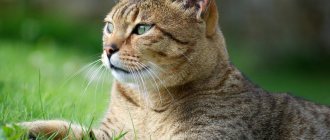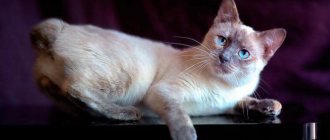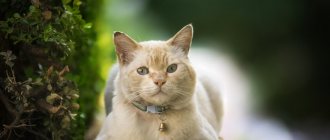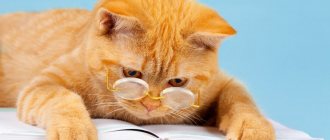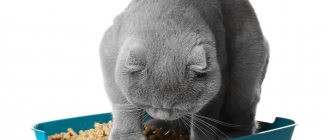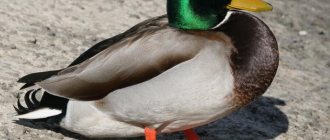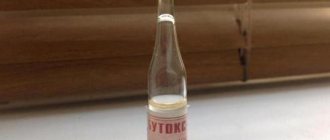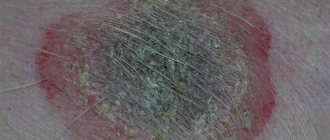Origin story
The ancestor of the Chausie is the jungle cat (marsh lynx, Hausie) - a predatory mammal that lived side by side with human settlements in Ancient Egypt for many years.
They were independent of humans, but often mated with domestic cats. The first hybrids appeared many years ago, but the Egyptians did not pay much attention to them, despite the external attractiveness of the latter: shiny sand-colored fur and large eyes, as if full of sunlight. The most that cats received was their portraits on frescoes. However, in the 20th century everything changed. American breeders were amazed by the wild beauty, took several individuals to the States and began work. External beauty was, of course, beyond competition, but the character of Egyptian cats left much to be desired: they loved freedom, but in the house they closed in on themselves, becoming gloomy and aggressive.
Such animals could not be offered as pets, which is why breeders tried (by injecting fresh blood) to soften this violent temperament. Through trial and error, it became clear: only Abyssinian cats are ideal.
The new breed was given the name Chausie (Housey), changing the second part of the full name Felis chaus and discarding the first. Work on the breed continued for a long time, but only in 1995 it received TICA status and a standard. Strange, but to this day this organization is the only one that recognizes the breed.
The breed is still very young, so there are few nurseries. Most of them are concentrated in the United States of America.
Features of the Chausie generations - F1, F2, F3, F4
The most frequently asked questions I get from potential Chausie kitten buyers are: What does the letter F and the numbers next to it mean? What are the differences between generations? What are the sizes of Chausie, which generation is larger? What is the price of this or that generation? Let's figure it out. Chausie F1 is the first, largest and most expensive generation obtained from crossing a wild jungle cat with an Abyssinian cat. The first hybrid generation of Chausie combines 50% of the genes of the Hausa (swamp lynx, jungle cat) and 50% of the Abyssinian cat. In this generation, Heterosis is clearly expressed (from the Greek heteroiosis - change, transformation, “hybrid strength”, acceleration of growth and increase in size, increase in vitality and first generation hybrids).
If you want to have a cat at home with the appearance and size of a wild jungle cat, but at the same time you like to be at home and spend a lot of time with your animals, then buy Chausie F1. These cats are closest to the wild jungle cat, but they require a lot of attention. F1 Chausies need constant love. If you or all members of your family travel frequently or leave home for more than 12 hours, we do not recommend that you buy Chausie F1.
F1 Chausies are distinguished by a gentle disposition, which is combined with independence and pride. With good care and love, the animal sincerely becomes attached to its owner with all its heart, at the same time considering itself to be his equal. They like to take an observer's position. Many Chausie F1 cats perceive observation as their immediate responsibility.
To live in harmony with such a unique cat as Chausie F1, you must truly love animals. It’s unlikely that Chausie F1 will be perceived as a plush toy. They endure all forced squeezing, squeezing and expression of their feelings with their characteristic composure and detachment. They do not welcome this method of communication, but they are characterized by more “doglike” behavior. This is expressed in a constant presence next to the owner, the cat is near the feet, receives caresses from the owner and responds to them. These cats do not like attention from strangers, a large number of people and noise around. They are lovers of a measured, understandable and familiar way of life.
The price for a Chausie F1 kitten starts from 130,000 rubles.
Chausie F2 is the second hybrid generation, in this case obtained from crossing a female Chausie F1 with an Abyssinian male. The jungle cat genes in this generation do not exceed 30%.
The second generation Chausie reacts more calmly to external stimuli and new objects. At the same time, Chausie F2 retains the exotic appearance of a jungle cat, although this generation is slightly inferior in size to F1. Because Chausie is sexually dimorphic (males are larger than females), the F2 male grows to be the same size as the F1 female. F2 girls are smaller than F1 girls. Male Chausie F1 will be the largest among all generations.
Overall, this is an ideal cat for a family with children and other animals. The character retains sensitivity and vulnerability, but resistance to stress is already more pronounced than in the case of Chausie F1. You should behave tactfully and delicately with Chausie F2. F2 is irritated and upset by the following things:
- Forced loneliness;
- Loud sounds;
- Change of residence;
- Intrusive caresses or rudeness of the owner.
The owner needs to find time to communicate with Chausie F2 and play with him in order to release his energy.
In order for the Chausie F2 kitten to quickly become attached to its owner, you need to pick it up, play and stroke it. With a lack of communication, the second generation, like the first, becomes withdrawn and wild. With enough attention, Chausie F2 grows up to be affectionate and sociable.
The price for a Chausie F2 kitten starts from 80,000 rubles.
Chausie F3 is the third hybrid generation obtained by crossing the Chausie F2 cat with an Abyssinian cat. Jungle cat genes do not exceed 13 percent. In this generation, Heterosis fades and Chausie F3 is inferior in size to both its wild ancestor and the first two generations of hybrids, while retaining the color of a wild jungle cat. Chausie F3 has increased stress resistance compared to the first two generations. They are calmer towards strangers, new things and changes. F3s still have that exotic behavior where they act “like dogs.”
The most inexpensive generation is Chausie F3. From 30,000 rubles.
F4 Chausies are very adaptive. Properly raised fourth generation Chausies are almost impossible to see irritated or aggressive. They are tolerant, intelligent and instinctively sense people's moods.
Regardless of which generation of Chausie you want to buy, the main thing is to purchase a kitten from a professional nursery, after consultation with the breeder.
Fertility of Chausie males
It is known that male hybrid cats of the first generations are infertile. In theory, Chausie males F1, F2, F3 cannot bear offspring. And only from the fourth generation, Chausie F4 males become fertile. However, history knows of cases when a second generation male from a jungle cat had offspring. Regarding the Chausie lines of the Benaby nursery, one of our graduates, Sir Arthur Benaby, who currently lives in New York City, was tested for fertility in a US laboratory. The result of the study is that the sperm are alive, but inactive. The male Chausie F2 was also left in the nursery; two trial matings were made between him and an F1 female, which did not bring any results. The F1 female was not fertilized. The Benabi nursery plans to test the fertility of third generation males, Chausie F3. Today in Russia it is not possible to check cats using an artificial ejaculation apparatus, due to its absence. Checking is possible only with the collection of ejaculate by a veterinarian under anesthesia. The breeder of the nursery decided not to subject the animals to anesthesia and to test the fertility of the third generation of Chausie in a natural way.
Standards
Houseys (Chausies) are extremely graceful cats, like miniature leopards. The height at the withers most often does not exceed 40 cm, but the weight is significant: 14-16 kg. Males are visually larger than females.
| Standard | Description |
| Head | Wedge-shaped, moderately elongated, small in size and without angularity. The forehead is wide, flat, the back of the head is smooth, the stop is sharp, the cheekbones are high and sharp. The nose is convex and brown. The bite is straight or scissor. The jaws are strong. |
| Eyes | Almond-shaped, close to each other. The iris can be painted in any shade of yellow and amber, and a slight admixture of green is also allowed. |
| Ears | Large and wide, widely spaced. On the outer side of the auricle there are small spots shaped like eyes: these are “hello” from Ancient Egypt. The tips are sharp, decorated with small tassels (optional). |
| Neck | Quite short and thick. |
| Torso | Strong, with smooth lines and well-developed muscles. The back is straight, the stomach is tucked, the chest is wide, the shoulders are narrow, and the pelvis is equally narrow. |
| Limbs | Long, slender, with wide elastic paws and outstretched toes. |
| Tail | Long, flexible, mobile. |
| Wool | Very thick and soft to the touch. A healthy coat is shiny and lies tightly. Undercoat is present. |
Breed defects:
- uneven back;
- indistinguishable stop;
- neck too long;
- round head;
- poorly developed chest;
- different eye color;
- ears that are small or too close together.
Serious defects in appearance for which a chausie is removed from competitions:
- cryptorchidism;
- deafness;
- lack of claws;
- white marks on the body;
- disproportionately short or knobby tail with kinks.
It is difficult to buy this amazingly beautiful cat. Firstly, because there are too many catteries, and secondly, the cost of Hausie cats is simply cosmic. Think about it: the price tag starts from 600 thousand rubles and sometimes reaches one and a half million!
Color
The standard provides 3 main colors:
- plain black (no markings);
- ticked black tabby (the undercoat is golden with a scarlet tint, there are points on the inside of the paws and tail, there is a light rim around the eyes, and the same on the chin);
- gray-black ticked tabby (ticked stripes on the guard hair - 2-3 pieces, the tips are always dark).
The photo shows a Coca of the Chausie (Housey) breed in the main colors
Character and behavior
“Wild on the outside, kind on the inside” - this is what is sung in a famous Soviet song. This line fits chausie perfectly: despite their sometimes stern appearance, these cats are friendliness itself. They are very sociable: they will definitely not let you and your guests get bored. However, independence is in their blood, as well as some obstinacy and a desire to defend their point of view on things that seem important and necessary to them. If a chausie chooses a resting place for itself, it will be almost impossible to drive it away from there.
And breeders speak with a grin about the Chausie’s habit of making hiding places with small household items: if you suddenly lose a hair tie, a key, lipstick, and so on, look for them somewhere under the furniture or in the closets. And don’t be surprised if you also find pieces of moldy bread or other food there - chausies are making supplies for a “rainy day.”
They are extremely intelligent and observant. Having studied your habits, Chausie will predict your actions and even help: for example, “offer” you warm slippers when you come home cold. This is not magic, but impeccably developed intuition. Thanks to their mental abilities, chausies quickly learn new things and carry out certain commands with pleasure. You can even teach them to jump into a hoop!
Very active and playful. They need a lot of space to run around and a play area where they can climb to their heart's content. If you cannot provide such conditions, do not buy this cat. Otherwise, the atmosphere in your apartment and your nerves will come to an end.
How did the cat move in K.I. Chukovsky’s famous poem “The Cockroach”?
jump backwards
They are good friends with both cats and dogs. Small rodents and birds are perceived exclusively as prey, so making them friends will not work. They communicate well with children, but they can give back if they are offended.
Chausie nurseries
There are several nurseries around the world, which is caused by difficulties in selection.
About 25 professional breeders involved in breeding the Chausie breed have registered their details with TICA. Almost all of them are residents of France and the USA. It is known that the reproduction of offspring of purebred animals is carried out in several states: Nevada, California, Florida and Arizona.
In Russia, the process of breeding the Chausie breed became interested only recently - in 2008. It turned out that you can buy real Chausie in an official nursery operating in Moscow. Ukraine and Belarus can also boast of their own breed nurseries. But at home, breeding chausie is impossible to organize in practice. This also explains their high cost.
It is recommended to purchase purebred animals from well-known registered nurseries, where buyers are offered instructions on how to care for cats, specially developed by caring breeders. The purchase of a real Chausie cat is accompanied by a special contract that considers issues such as reproduction of offspring, participation in exhibitions and some others.
Experts advise not to buy a pet under three months of age. In addition, it is necessary to carefully check the live “purchase” for compliance with breed standards and ensure that all documents contain the necessary marks.
Care instructions
Chausie care is standard.
Wool
The silky and dense coat is combed once a week with any massage brush (with natural, not iron bristles). This will not only tidy up the coat, but also improve blood circulation. During molting, the procedure can be carried out more often - 2-3 times a week.
Bathing
You can bathe Chausies often: they love it, and their skin can cope with the production of a protective layer without problems. But don’t use human shampoos - buy a special cat shampoo (“Clandestine”, Doctor ZOO, “Deep Cleaning” Cliny).
Eyes
Chausie's eyes don't flow. The ears are examined weekly and dirt is removed with a damp cotton pad.
Teeth
With teeth, everything is more complicated: chausies do not like it when someone persistently tries to get into their mouth with a brush. Therefore, try to accustom your cat to this procedure from an early age, and drip plaque-cleaning gel into the drinking water.
In the photo there is a cat of the Chausie (Housey) breed on a walk in the park
Pros and cons of chausie
Any breed has certain advantages and disadvantages. Before you get an animal, you should thoroughly study all its features.
Advantages of the Chausie breed:
- Representatives of this breed are intended for true connoisseurs of animal beauty;
- Gets along and quickly finds a common language with other pets;
- Loves children and does not show aggression towards them;
- During the game it will never injure or scratch the owner;
- Features an incredible, exotic and unforgettable appearance;
- Has good health and strong immunity;
- A very sociable, cheerful and mischievous cat. She loves outdoor games and fun;
- Doesn't require much attention.
Disadvantages of the Chausie breed:
- A very expensive breed that not everyone can afford;
- Quite rare. In Russia there are no more than a dozen representatives of this breed;
- Requires a lot of space;
- Cats often become infertile, unable to produce offspring;
- It is necessary to monitor nutrition, as this is one of the animal’s weaknesses. They do not tolerate fatty meats and grains, they only need filtered or boiled water;
- If cats are left alone for a long time, you can end up with damaged furniture and interior items, as well as torn wallpaper and curtains;
- Animals are prone to obesity due to poor diet and lack of physical activity;
- Caring for and maintaining pets is quite expensive.
Catering
Chausie's passion for raw meat is in his blood. A large, juicy bone that can be deliciously torn into pieces is not only a favorite delicacy, but also an opportunity for a chausie to feel like a wild animal.
Natural products
The main food for chausie should be the following products:
- Meat. Raw is the most delicious, but the unprocessed product may contain parasite larvae and pathogens. Therefore, first thoroughly freeze the piece in the freezer (at least 2 days), then defrost it and pour it over with boiling water. You cannot grind it into mince: the cat must massage the gums, and the soft mass will not allow this. Allowed types: veal, beef, chicken, turkey, rabbit, horse meat, kangaroo meat, quail meat. If you have the opportunity to buy feed mice and day-old chicks, they are fed without treatment.
- Offal. These are poultry, beef and turkey hearts, liver, chicken stomachs, cartilage, necks, chicken heads, tongues, kidneys, lungs, udder, spleen, beef tripe. They are combined and mixed with vegetables.
- Fish. An excellent source of protein, vitamins and fatty acids. Acceptable species: hake, flounder, blue whiting, sea bass, trout, chum salmon, pink salmon, salmon, pike perch, tench. It is better not to feed fatty fish (saury, ivashi, saberfish, silver carp, eel, herring).
- Dairy products. These are cottage cheese, kefir, yogurt, natural yogurt - given as a treat 2-3 times a week. Cottage cheese can be mixed with a boiled quail egg or boiled chicken yolk (the white can cause intestinal upset).
- Vegetable stew. Carrots, beets, zucchini, broccoli, asparagus, herbs (parsley, dill). Some animals are not averse to gnawing on a fresh cucumber, watermelon or melon.
In addition to food, cats need to be given vitamins and minerals (choose a good complex), as well as yeast tablets.
Chausie cats are fed 2 times a day: at 7-8 am and 6-7 pm. Snacking between meals is best avoided.
Chausie drinks often and in large quantities, so give him not one, but two bowls, and change the water 2 times a day. It is better to take purified liquid: distilled or settled. Tap water is harmful to a cat's stomach.
Expert opinion
Dusheba Vera Ivanovna
In 2010, she graduated from the Moscow State Academy of Veterinary Medicine named after K.I. Scriabin with honors, specializing in veterinary medicine. I regularly attend veterinary conferences, congresses, and webinars.
It is strongly not recommended to feed Chausie cats with dry food and cereals!
Chausie should not be given to:
- fat meat;
- human drinks: alcohol, juices, tea, coffee, cocoa;
- pickled, fried, salty, sweet, sour, smoked foods;
- citrus;
- legumes, potatoes, tomatoes, eggplants, grapes, dried fruits;
- whole cow's milk;
- mushrooms, nuts;
- dog food.
You can give baked goods and flour, but rarely and little by little.
Features of feeding
Like other cat hybrids of the first generations, F1-2 do not tolerate ready-made food. Sometimes it is possible to find a brand, but in most cases attempts end in loose stools.
Therefore, we often talk about natural products:
- turkey, rabbit, veal, lamb 60%
- boneless fish, boiled white sea fish 20%
- rice, fresh herbs, sprouted oats 10%
- cottage cheese, eggs 10%
Some owners give whole carcasses or buy fish, poultry, rabbits and rodents alive so that the pet can satisfy the hunting instinct. For safety reasons, breeders do not recommend disturbing F1-2 while eating. When feeding raw meat and having access to live prey, the pet is given anthelmintic drugs three times a year.
Chausie F3 is also a suitable diet for active breeds of cats, rich in easily digestible proteins. Good food or natural products - it doesn’t matter, the menu will be selected by the breeder or veterinarian. The kitten's diet can be adjusted after a 30-day adaptation period in the new home.
It is important to ensure that your pet does not overeat and does not stockpile in secluded places. They have a great appetite, but not everyone manages to exercise enough to burn off the calories they receive. In addition, only sterile kittens are usually available to the general public, and this is an additional factor contributing to obesity.
Diseases
The immunity of Chausie cats is excellent, but in terms of genetics there are some nuances.
Firstly, representatives of this breed have a weak digestive system, which requires a special diet and selection of food. Their intestinal tract is significantly shorter than that of other breeds, which is why cats cannot fully digest plant foods and fiber. No cereal porridge!
Secondly, they are prone to overeating. This is not a disease, but a cause that can cause a number of serious ailments, so portion sizes should be carefully monitored.
Thirdly, cats up to the 3rd generation cannot have offspring. Keep this in mind when choosing your pet.
In all other respects, Chausie is in complete order! These cats are real long-livers, capable of delighting you with their presence for 18-20 years. Agree, this is a considerable period of time.
Expert opinion
Dusheba Vera Ivanovna
In 2010, she graduated from the Moscow State Academy of Veterinary Medicine named after K.I. Scriabin with honors, specializing in veterinary medicine. I regularly attend veterinary conferences, congresses, and webinars.
Vaccination is a good preventative measure that will protect your pet from a number of diseases. Calicivirus, chlamydia, panleukopenia, rabies, rhinotracheitis are deadly, so do not refuse vaccinations even if your cat is an absolutely domestic creature who does not even take a step outside the threshold. You can also bring pathogens into your home without wanting to: on your fingers, on your shoes or clothes.
Video
* We invite you to watch a video about the Chausie . In fact, in front of you is a playlist in which you can select and watch any of 20 videos about a given cat breed by simply clicking on the button in the upper right corner of the window. In addition, the material contains quite a lot of photos. By looking at them you can find out what Chausie looks like.
Rate the material!
[Total votes: 0 Average: 0]
Today there is a wide variety of cat breeds. Chausie cats as the most exclusive and unusual. This breed was developed by crossing a domesticated Abyssinian cat and a jungle cat. As a result of crossing a rare breed with a wild cat, the result was a cat of incredible beauty and grace. Representatives of this breed are among the five most expensive cats in the world. They are believed to have an incredibly graceful, attractive, aristocratic appearance and a combination of incredible genes.
Photo gallery
Below are photos of cats of the Housey (Chausie) breed.
